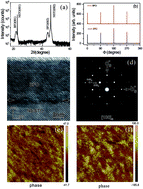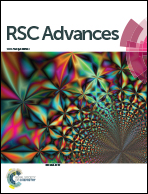Impact of interfacial effects on ferroelectric resistance switching of Au/BiFeO3/Nb:SrTiO3(100) Schottky junctions†
Abstract
Direct evidence of purely interfacial effects on resistance switching is demonstrated in Au/BiFeO3/Nd:SrTiO3(001) (Au/BFO/NSTO) Schottky junctions by reducing the thickness of ferroelectric interlayer BFO. The Au/BFO/NSTO junction shows large current rectification and hysteretic resistive switching behavior without any electroforming process. The conduction mechanism is dominated by interface-limited Fowler–Nordheim (FN) tunneling through a potential barrier formed at the BFO/NSTO interface. Measurements of polarization switching dynamics and capacitance–voltage characteristics provide direct evidence that the resistance switching in the Au/BFO/NSTO junction is ferroelectric and interfacially limited. The observed resistance switching behavior can be attributed to the ferroelectric polarization modulation of the barrier and depletion width of the p–n junction formed at the BFO/NSTO interface.



 Please wait while we load your content...
Please wait while we load your content...